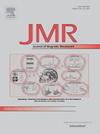Rela2x: Analytic and automatic NMR relaxation theory
IF 1.9
3区 化学
Q3 BIOCHEMICAL RESEARCH METHODS
引用次数: 0
Abstract
Spin relaxation is modelled using the so-called relaxation superoperator . Analytic forms of have been derived in the literature in the simplest cases of one- or two-spin systems, with nuclei and no more than two different simultaneous relaxation mechanisms involved. Beyond that, for systems of more than two spins, with and/or multiple relaxation mechanisms at play, the derivations become notoriously complicated, which is why analytic relaxation theory has mostly been considered a dead end. Instead, numerical methods of constructing have been popular. However, they lack some of the physical, chemical and pedagogical insight that can be provided by analytic expressions. To this end, we present a general, interactive and freely available Python programme, named Rela2x, to automatically compute the analytic matrix representation of for high-field NMR. Tools to analyse, approximate and visualize are built into Rela2x. As a demonstration of the functionality, is presented both for the familiar dipole–dipole coupled H-H spin system and for more complicated H-14N and H-13C-14N systems with dipole–dipole coupling, chemical shift anisotropy and quadrupole interaction. We envision that the code will provide much-needed clarity in the form of a helpful tool for the study of relaxation effects, and constitute a reference source for scientists in the field of NMR.

Rela2x:分析和自动核磁共振弛豫理论。
自旋弛豫是用所谓的弛豫超级算子Γ}}来建模的。在最简单的单自旋或双自旋系统中,在S=12个原子核和不超过两种不同的同时弛豫机制的情况下,文献中已经推导出了Γ´´的解析形式。除此之外,对于超过两个自旋的系统,具有S bbb12和/或多个松弛机制,推导变得非常复杂,这就是为什么解析松弛理论大多被认为是死胡同。取而代之的是,构建Γ的数值方法一直很流行。然而,它们缺乏解析表达式所能提供的一些物理、化学和教学方面的洞察力。为此,我们提出了一个通用的、交互式的、免费的Python程序,名为Rela2x,用于自动计算高场核磁共振Γ的解析矩阵表示。Rela2x内置了分析、近似和可视化Γ的工具。为了证明该方法的功能性,我们给出了Γ↓↓,用于我们熟悉的偶极子-偶极子耦合1H-1H自旋系统,以及更复杂的具有偶极子-偶极子耦合、化学位移各向异性和四极相互作用的1H-14N和1H-13C-14N系统。我们设想该代码将以研究松弛效应的有用工具的形式提供急需的清晰度,并构成核磁共振领域科学家的参考来源。
本文章由计算机程序翻译,如有差异,请以英文原文为准。
求助全文
约1分钟内获得全文
求助全文
来源期刊
CiteScore
3.80
自引率
13.60%
发文量
150
审稿时长
69 days
期刊介绍:
The Journal of Magnetic Resonance presents original technical and scientific papers in all aspects of magnetic resonance, including nuclear magnetic resonance spectroscopy (NMR) of solids and liquids, electron spin/paramagnetic resonance (EPR), in vivo magnetic resonance imaging (MRI) and spectroscopy (MRS), nuclear quadrupole resonance (NQR) and magnetic resonance phenomena at nearly zero fields or in combination with optics. The Journal''s main aims include deepening the physical principles underlying all these spectroscopies, publishing significant theoretical and experimental results leading to spectral and spatial progress in these areas, and opening new MR-based applications in chemistry, biology and medicine. The Journal also seeks descriptions of novel apparatuses, new experimental protocols, and new procedures of data analysis and interpretation - including computational and quantum-mechanical methods - capable of advancing MR spectroscopy and imaging.

 求助内容:
求助内容: 应助结果提醒方式:
应助结果提醒方式:


